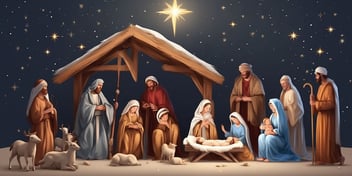- Blog
- Christmas questions
- What is the history of the Christmas nativity scene or creche?

Christmas is a time of twinkling lights, carol-filled nights, and the heartwarming sight of a nativity scene nestled beneath the Christmas tree. But have you ever wondered how this cherished holiday tradition came to be? Steeped in rich history and mythology, the nativity scene, also known as the creche, has captivated hearts for centuries.
As we unwrap the origins of this timeless symbol, be prepared to embark on a historical journey that intertwines faith, artistry, and the universal spirit of the holiday season. So gather 'round, for the tale of the Christmas nativity scene is about to begin.
Origin of the Nativity Scene
Early Christian Roots
Early Christian Roots: The tradition of the nativity scene finds its roots in early Christianity. In the 4th century AD, early Christians began to depict the birth of Jesus in artistic forms. These representations were primarily found in catacombs, where the faithful gathered to worship and honor the life of Jesus. The nativity scene served as a visual reminder of the humble beginnings of Jesus, emphasizing the significance of his birth.
Over time, this tradition gained popularity and spread throughout churches and homes, eventually becoming an integral part of Christmas celebrations worldwide. Today, the nativity scene continues to remind believers of the true meaning of Christmas, emphasizing the importance of Jesus' birth in the Christian faith.
Saint Francis of Assisi
Saint Francis of Assisi, a significant figure in the history of the nativity scene, played a crucial role in popularizing its use. In the 13th century, he sought to bring the story of Jesus' birth to life by creating a live nativity scene in Italy. By using real people and animals, he aimed to help people visualize and connect with the biblical account. This innovative approach resonated with the public and soon spread throughout Europe.
Today, many nativity scenes still follow the portrayal initiated by Saint Francis, showcasing his enduring influence on this cherished Christmas tradition.
Spread throughout Europe
The nativity scene rapidly spread throughout Europe, becoming a popular Christmas tradition. It was embraced by various cultures, each incorporating their own unique elements. In Italy, for instance, nativity scenes are known for detailed craftsmanship and intricate figures. In Spain, it is common to find nativity scenes in homes, churches, and public squares. Germany is renowned for its large-scale nativity scenes, often displayed in churches during Advent.
The popularity of nativity scenes across Europe helped to deepen the connection between Christmas celebrations and the story of Jesus' birth, making them an integral part of the holiday season.
Evolution of the Nativity Scene
Baroque and Renaissance Influence
- Baroque and Renaissance art movements had a significant impact on the depiction of nativity scenes during Christmas.
- Artists in these periods incorporated intricate details, vibrant colors, and dramatic lighting to create emotionally powerful scenes.
- The use of perspective and realism in these artistic styles brought a sense of authenticity to nativity representations.
- The influence of Baroque and Renaissance can be seen in the elaborate Nativity scenes found in churches and museums around the world.
- These artistic movements elevated the nativity scene to a form of high art, inspiring awe and reverence among viewers.
Nativity Scenes in Churches
Nativity scenes in churches are a common sight during the Christmas season. They serve as powerful visual reminders of the birth of Jesus and the true meaning of Christmas. These displays often feature figurines depicting Mary, Joseph, the baby Jesus, the shepherds, the wise men, and various barn animals. The nativity scene helps to create a sacred atmosphere and allows worshippers to reflect on the humble beginnings of Jesus.
Churches may also incorporate live nativity scenes, where individuals dress up as the biblical characters, bringing the story to life for worshippers. This immersive experience helps deepen the spiritual connection and engages community members in the celebration of Christ's birth.
Popularization of Nativity Scenes
The popularization of nativity scenes during Christmas plays a significant role in promoting the story of the birth of Jesus. These symbolic displays have become widely embraced by Christians and non-Christians alike, adding to the festive ambiance of the holiday season. Nativity scenes are commonly found not only in churches but also in public spaces, such as town squares, shopping malls, and even private homes.
Their widespread presence serves as a reminder of the true meaning of Christmas and helps spark curiosity and conversations about the biblical story. Whether it's a life-sized scene in a park or a miniature set on a mantelpiece, nativity scenes have become an integral part of Christmas celebrations worldwide.
Modern Nativity Scenes
Variations and Cultural Adaptations
- The nativity scene has undergone numerous variations and cultural adaptations throughout history, reflecting the diverse traditions and customs worldwide.
- In South America, it is common to find nativity scenes featuring local scenery and traditions, such as Amazon rainforest settings or Andean villagers.
- In Mexico, nativity scenes often include unique elements like cacti and characters from local folklore.
- In African countries, the nativity scene may incorporate traditional African clothing and animals native to the region.
- These cultural adaptations not only make the nativity scene more relatable and meaningful to communities, but also showcase the universality of the Christmas story.
Contemporary Artistic Interpretations
Contemporary artistic interpretations of nativity scenes have brought fresh perspectives to the traditional Christmas symbol. Artists today embrace various mediums, including sculpture, painting, and even digital art, to present nativity scenes that resonate with modern audiences. These interpretations often incorporate diverse cultural elements, challenge conventional imagery, and explore themes of social justice and inclusivity.
For instance, artists may depict the Holy Family in different ethnicities or represent the nativity scene in unconventional settings to convey underlying messages of unity and compassion. These contemporary art pieces invite viewers to reflect on the universality of the Christmas story and its relevance in the present day.
Outdoor Nativity Scenes
- Outdoor nativity scenes are becoming increasingly popular, adding a festive touch to Christmas decorations.
- They allow individuals to share the story of Christ's birth with their community and passersby.
- These scenes are often displayed in front yards, gardens, or public spaces, inviting people to reflect on the true meaning of Christmas.
- Outdoor nativity scenes come in various sizes and designs, ranging from traditional to modern interpretations.
- Some people even create life-size or illuminated nativity scenes to create a captivating visual experience.
- These scenes can serve as a reminder of the religious significance of Christmas and spark conversations among neighbors and visitors.
Christmas Questions: Nativity Scene Traditions
Why is the nativity scene placed under the Christmas tree?
The nativity scene is often placed under the Christmas tree as a way to highlight the significance of the birth of Jesus Christ. It serves as a visual reminder of the true reason for celebrating Christmas and helps to focus on the spiritual aspect of the holiday. By positioning the nativity scene near the Christmas tree, families can symbolize Christ's presence as the central figure in their festivities.
This tradition encourages reflection on the biblical story of Jesus' birth and deepens the religious significance of the holiday.
When did nativity scenes become common in households?
When did nativity scenes become common in households? Nativity scenes began to gain popularity in households during the 18th and 19th centuries. As Christmas traditions evolved, families started incorporating nativity scenes as a way to celebrate the birth of Jesus and emphasize the religious aspect of the holiday. This widespread adoption can be attributed to the increasing availability of pre-made nativity sets and the desire to create a visual representation of the biblical story.
Today, it is common for families around the world to display nativity scenes in their homes during the Christmas season as a reminder of the true meaning of Christmas.
What are some famous nativity scenes around the world?
When it comes to famous nativity scenes around the world, there are several notable ones that attract visitors from near and far. One such example is the life-size nativity scene in St. Peter's Square at the Vatican, which is unveiled on Christmas Eve and remains on display throughout the holiday season. In Germany, the Krippenweg in the city of Bamberg showcases over 30 nativity scenes, each uniquely crafted by local artists.
Additionally, the Sanctuary of Sant Salvador in Mallorca, Spain, presents a stunning nativity scene with intricate details and figurines. These famous displays offer a glimpse into different cultural interpretations of the nativity story, enriching the Christmas experience for visitors.
Wrapping up
The history of the Christmas nativity scene, also known as a creche, spans many centuries. It originated in Italy during the 13th century and quickly gained popularity throughout Europe. The concept was inspired by St. Francis of Assisi, who wanted to bring the story of Jesus' birth to life. He set up the first nativity scene in a cave, complete with live animals and actors portraying biblical characters.
Over time, the tradition spread to churches and homes, with people creating their own nativity scenes using figurines and miniature replicas. Today, the nativity scene remains a cherished symbol of the Christmas season, reminding us of the humble beginnings of Jesus and the true meaning of the holiday.
Read On

What is the history of the Christmas nativity scene or creche?
Ah, the Christmas season—a time of twinkling lights, cozy carols, and the beloved nativity scene...

Delve into the Meaning of Merry Christmas Nativity Scenes
Ah, the beloved Christmas nativity scenes - those enchanting little dioramas that magically appear...

What is the history and cultural significance of the Christmas nativity play?
Every year, as Christmas draws near, communities around the world come alive with the familiar...